Shore-Based Power Provided for all Vessels at Rotterdam WG

The Rotterdam World Gateway (RWG) container terminal has announced plans to install shore-based power systems along its entire dockside, allowing all docking vessels to access this facility.
RWG, which already operates as a fully automated and CO2-neutral facility, will extend its environmental initiatives by enabling docked ships to eliminate emissions of particulates, nitrogen, and CO2. The introduction of shore power is also expected to diminish noise pollution in the area.
Shore power connectivity is anticipated to begin installation at the first berths by 2026, positioning RWG to surpass the forthcoming European mandate. This mandate requires all container, passenger, and cruise vessels exceeding 5,000 deadweight tonnage (dwt) to utilize shore-based power when docked in European harbors by 2030. RWG has committed to independently designing, funding, and constructing these shore power installations.
A mutual agreement to exchange insights and information related to the development and application of shore power, as well as the associated civil engineering adjustments to the quay walls and fenders, has been formalized between the Port of Rotterdam Authority and RWG through a letter of intent.
Boudewijn Siemons, CEO and interim COO of the Port of Rotterdam Authority, expressed satisfaction with RWG's initiative as the pioneering deep-sea terminal in Europe to invest in shore power, highlighting its significant role in enhancing the sustainability of supply chains that pass through Rotterdam for their mutual clientele.